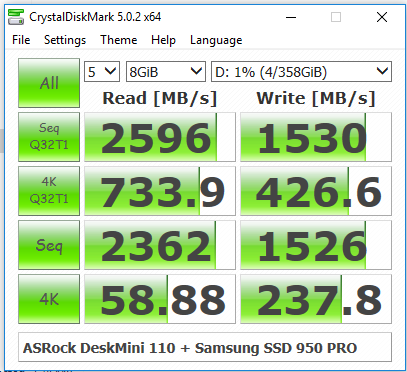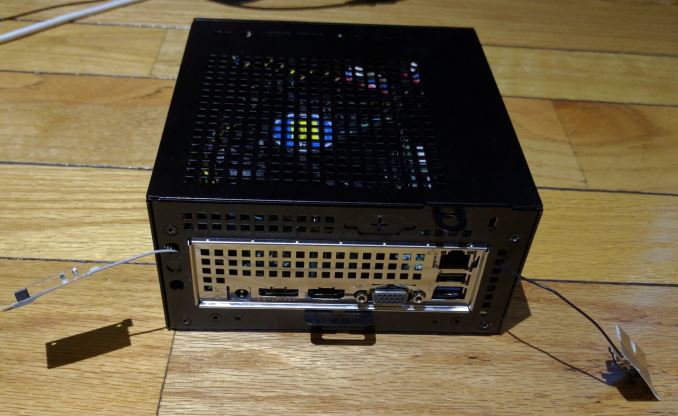ASRock DeskMini 110 mini-STX PC Review
by Ganesh T S on June 8, 2016 8:45 AM ESTNetworking and Storage Performance
Networking and storage are two major aspects which influence our experience with any computing system. This section presents results from our evaluation of these aspects in the ASRock DeskMini 110. On the storage side, one option would be repetition of our strenuous SSD review tests on the drive(s) in the PC. Fortunately, to avoid that overkill, PCMark 8 has a storage bench where certain common workloads such as loading games and document processing are replayed on the target drive. Results are presented in two forms, one being a benchmark number and the other, a bandwidth figure. We ran the PCMark 8 storage bench on selected PCs and the results are presented below.


Despite using the same SSD, we do see some difference in scores between Skull Canyon and the DeskMini. This probably results from differences in the CPU capabilities, since the storage bandwidth actually reflects the amount of time that the CPU was waiting on at least one I/O request to the disk.
The important aspect to test from the DeskMini viewpoint is PCIe 3.0 x4 support (since the H110 has only PCIe 2.0 support). We ran the quick CrystalDiskMark check and could see that the Samsung SSD 950 PRO showed its quoted performance numbers.
On the networking side, we restricted ourselves to the evaluation of the WLAN component. Our standard test router is the Netgear R7000 Nighthawk configured with both 2.4 GHz and 5 GHz networks. The router is placed approximately 20 ft. away, separated by a drywall (as in a typical US building). A wired client is connected to the R7000 and serves as one endpoint for iperf evaluation. The PC under test is made to connect to either the 5 GHz (preferred) or 2.4 GHz SSID and iperf tests are conducted for both TCP and UDP transfers. It is ensured that the PC under test is the only wireless client for the Netgear R7000. We evaluate total throughput for up to 32 simultaneous TCP connections using iperf and present the highest number in the graph below.

In the UDP case, we try to transfer data at the highest rate possible for which we get less than 1% packet loss.

Our main aim with the WLAN component was to show that the DeskMini could indeed support a M.2 PCIe WLAN module. Intel actually provided us with a AC8260 card meant for the Skull Canyon NUC. Therefore, the antenna type we got was really not a good fit for the all-metal chassis. We ended up doing the above evaluation with the antennae not mounted to the chassis, but just hanging out of the system. Despite this unwieldy setup, the system had no trouble getting good numbers in our bandwidth test.
The DeskMini chassis does provide three perforations diagonally across the M.2 WLAN slot in the rear to install screw-type antennas. Consumers can keep this in mind while hunting for the appropriate WLAN component to complete a DeskMini build.












85 Comments
View All Comments
aethertron - Sunday, June 12, 2016 - link
I'm new to this, does the i5 HQ version draw the same power and get the same clock as the 65 W desktop version? I was thinking of this form factor because I was hoping to put full-power desktop components in a smaller form factor.extide - Monday, June 13, 2016 - link
That IS a full power normal desktop CPU, like you can buy at newegg.Gadgety - Wednesday, June 8, 2016 - link
@TS Ganesh " larger than the NUCs, but smaller than a mini-ITX build"Why do you not list case dimensions in the specifications as this is part of the point of evaluating this offering?
t.s - Wednesday, June 8, 2016 - link
seconded. A review about SFF, without the dimension is quit funny.ganeshts - Wednesday, June 8, 2016 - link
Approx. 6.125" x 6.125" x 3.125" by rough measurements. That comes to ~1.9L, but ASRock claims 1.82L in their press release. I might be off by 0.1" or so in the hurried measurements that I took.Btw, you can get an idea of how small the case is from the photo here: http://www.asrock.com/news/index.us.asp?id=3303
Gadgety - Wednesday, June 8, 2016 - link
Thank you.fanofanand - Wednesday, June 8, 2016 - link
Thank you Ganesh, I am awful at visualizing dimensions, that picture changes my entire opinion of this device. I went from simply being bummed about the PCI-e being at 2.0 speeds to being stoked at the possibilities. I am still holding out hope for a usable (FB, Youtube etc.) USB stick PC, but I may give up waiting (will likely be years for that to be realized) and just go for something like this. Great article Ganesh!QChronoD - Wednesday, June 8, 2016 - link
I was expecting to see a picture of this next to a modular PSU with the caption of "Can you guess which is which?"Michael Bay - Saturday, June 11, 2016 - link
Same here, looks just like a fancy PSU would.Eden-K121D - Wednesday, June 8, 2016 - link
Where is the GTX 1080 review ?